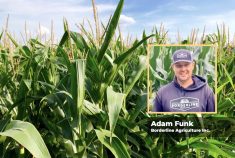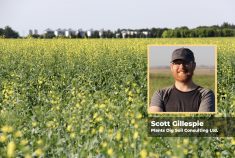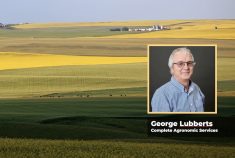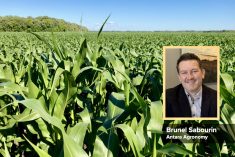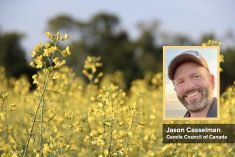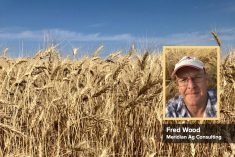Don Lobb takes a very dim view of how mankind has treated soil over the millennia, but he is slightly more hopeful for this generation, due both to our constantly growing body of knowledge about soils, and to farmers who are not only willing to experiment with better ways to take care of the soil, but also pass on their findings to their peers.
It all helps explain why Lobb is on the steering committee of the Ontario Soil Network.
“What happens is that every time there are high crop prices, people have gone out and destroyed the soil,” says the former farmer, long-time soil advocate, and director-at-large of Soil Conservation Council of Canada. “It just goes on and on — we never learn — even the Greeks in 350 B.C. had figured out that tillage was a problem and banned plowing on sloping land.”
Lobb then cites the 1920s, when the U.S. and Canadian governments wanted to expand production, encouraging people to move out onto fragile land. At the same time, there was a transition from animal horsepower to engine horsepower, allowing for even greater destruction. Horrendous erosion ensued, with the Dust Bowl and big gulleys opening up in the Appalachians and Ontario.
Lessons were learned and soil conservation programs encouraging better practices were set up north and south of the border. But the next time around, when prices rose in the 1970s, everybody went back to the old ways of cropping every inch of arable land — even, as Lobb says, “growing white beans on 15 per cent slopes, which was stupid.”

Pasture land was ripped up, air-conditioned tractor cabs came on the scene, and tillage was king. Yet once again, serious problems occurred, including the near-death of Lake Erie from algae.
By the 1980s, programs again were implemented, including Ontario’s SWEEP (Soil and Water Environmental Enhancement Program), which focused on reducing algae-producing phosphorus levels in Lake Erie, and that included other soil-saving measures as well.
“We made real progress — we moved no till forward really quickly, and we got a lot of support,” Lobb says. But priorities change, governments change, and people revert back to their old ways. When crop prices went up in this past decade, grasslands in traditionally beef-raising areas like Bruce and Grey Counties were taken out, plowed up and seeded into crops.
Read Also

Sensing the soil: Root cell research finds ‘stress hormone’
Research into how root cells react to soil stressors could help plants better adapt to changes in their climate.
Lobb admits there’s a temporary yield boost produced by releasing carbon through tilling previously pastured land, but it goes away fairly quickly, and the quality of the soil goes into decline as the cycle goes on again.
“Now,” says Lobb, with an air of the inevitable, “there’s another resurgence in trying to protect the soil.”
But maybe this time it will be different, because part of today’s resurgence is the Ontario Soil Network, which is aiming to break the cycle by encouraging the adoption of better long-term soil health practices on farms across the province.
It’s a pilot leadership course that includes 40 farmers and 10 researchers, extension and policy staff from the Ontario government and conservation authorities. The goal is to spread the word on decreasing tillage and chemical inputs while increasing the use of cover crops and organic amendments.
The farmer participants are from across the province and represent a wide variety of commodities and organizations. They have already been active at conferences and speaking events.
“We’re in the minority — soil health is not being advocated enough, and we need to make it mainstream,” steering committee member Gord Green says. “The whole idea of the soil network is to have a support system so farmers can share ideas and experiences, and people who want to get into it have a resource network to lean on.”
Green is the past president of the Ontario Soil and Crop Improvement Association and has been strip tilling and no tilling on his cash crop and dairy farm for 25 years. He, too, is passionate about soil health and understands the importance of keeping living roots in the soil. Among the many practices he has taken up is using cover crops to feed his heifers.
Green warns that while there are many farmers doing good things for their soil, there aren’t really good numbers to back them up, and there are persistent problems.
“We don’t have it all figured out by any stretch,” Green says, citing a conference call he recently was on trying to find a way to suppress slugs in cover crops.
That’s why he’s a big believer in research, and why he supports side-by-side trials that are being carried out now in Ridgetown and other places to test the efficacy of the practices being advanced by the network.
The network’s tagline is “connecting farmers for the good of the soil,” and Melisa (Mel) Luymes, the project co-ordinator, explains it as reinvigorating, not reinventing what farmers are already doing.
“Farmers are always learning from other farmers,” says Luymes. “The networks already exist — this is a way of formalizing it and measuring it.”
Ken Laing agrees. Laing represents the Ecological Farmers Association of Ontario on the network and owns the 93-acre Orchard Hill Farm, which produces fruits and vegetables for 100 families that participate in his Community Shared Agriculture.
“Farmers pick up a certain amount from researchers and extension people, but when it comes down to it they really want to see other farmers doing something successfully before they’ll stick their neck out,” Laing says. “It’s great both socially and agronomically to get these innovative farmers together to talk to each other — they’re scattered all over, are a little isolated from neighbours and many are considered a bit crazy because they do things differently.”
The course kickoff was a two-day workshop in late March that included presentations, break-out discussion groups and networking.

Highly qualified professionals provided information and resources on what it takes to be a leader and how to put together a compelling presentation. They also talked about leading-edge soil health practices in Quebec and the United States. Participants were taken through the latest available research and programs, as well as how in-field trials are bolstering confidence in research results.
The project itself is a bit groundbreaking, since the participants themselves actually mapped out how they were going to operate during the ensuing 10 months.
Luymes is adamant on the point that the course “has to be farmer-driven. It’s the first and foremost principle here.”
It seems to be working. In the first two months of the network’s existence, 40 participants spent 970 hours hosting 15 events like crop tours and open houses, speaking at 24 events like conferences and workshops, engaging in 225 one-on-one conversations and talking to 22 small groups. Members of the group also use social media — especially Twitter — and participate in webinars. A total of 2,285 farmers and 1,614 industry representatives were engaged during this time.
The network is administered by the Rural Ontario Institute and supported financially by the Ontario Ministry of Agriculture, Food and Rural Affairs (OMAFRA). The Ontario Soil & Crop Improvement Association (OSCIA), Innovative Farmers Association of Ontario (IFAO), Ecological Farmers Association of Ontario (EFAO), and Farm & Food Care Ontario, with the Soil Conservation Council of Canada (SCCC) also as supporters. A total $60,000 is being spent over two years on the project, which wraps up in February 2018.
Laurent (Woody) Van Arkel, another steering committee member, has cash crops and livestock near Dresden. He started a group called Cover Crops Anonymous about five or six years ago.
“It’s pretty informal — there are about 10 of us who get together because someone has a problem or a question,” Van Arkel says. The afternoon meetings are usually in someone’s kitchen, a church basement, or the boardroom of the grain elevator — wherever they can get space on short notice.
Van Arkel sees the network as an expansion of the work he’s been doing, and thinks it’s a great way for “the guys who are quietly doing their own thing, and putting them where they can best use their talents.”
Having a wider group of people chatting with their neighbours in one-on-one conversations or in small groups across the province means people like him don’t have to take as much time away from their farms for meetings.
Van Arkel is on the speaking circuit giving presentations at the Southwest Agricultural and Innovative Farmers conferences, and he regularly gets phone calls and Tweets about what other farmers’ cover crops are doing and how they can do better. With Twitter, he says there’s a lot of give and take, and he gets back as much advice as he gives out.
The network will continue providing resources and support for the participants for the next few months. A website has been set up at ontariosoil.net where there are explanatory videos of different soil health practices, upcoming events are posted and farmers can plug into the knowledge network.
As for breaking the cycle of making higher profits by destroying the soil, Don Lobb says that, this time, we have to get it right because there’s no more land for expanding crops. On the upside, he adds, we’re starting to learn how to build up the soil while we’re growing crops, which is a new twist in the ongoing battle to protect this crucial resource.
As for the future of the network, there will be a course graduation and stakeholder meeting in February 2018 at which Luymes hopes to have a wide array of industry, government, academia and farmer participants exchanging ideas, evaluating the experience — and discussing next steps.



